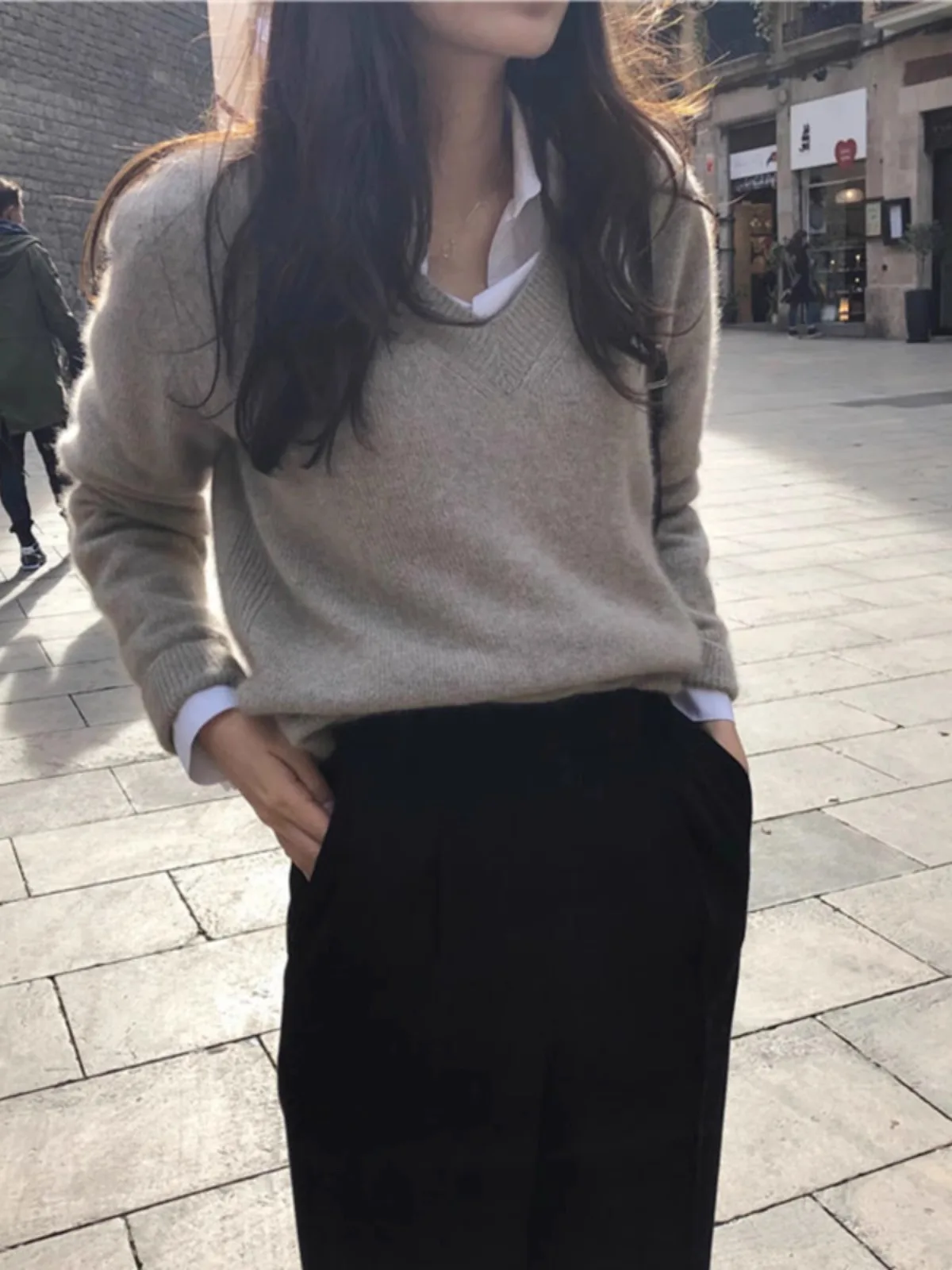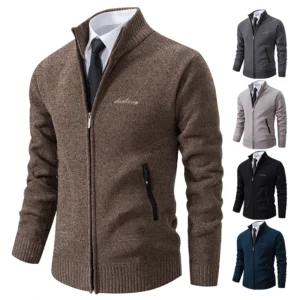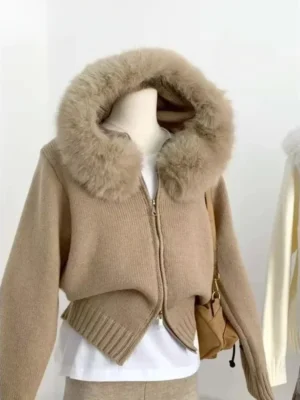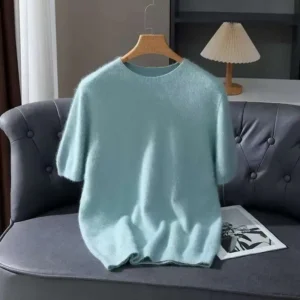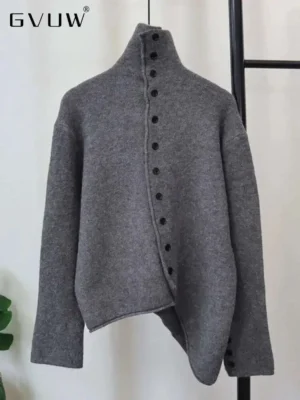Understanding Lightweight Cashmere: The Versatile Luxury Fiber
Lightweight cashmere represents the pinnacle of versatile luxury in the fiber world. Technically defined by its fine gauge knits (under 16 microns in diameter) and reduced ply count, lightweight cashmere offers extraordinary softness while maintaining exceptional durability. Unlike traditional cashmere, which tends to be dense and primarily suited for cold weather, lightweight variations weigh significantly less while delivering remarkable warmth.
What truly sets lightweight cashmere apart is its unique combination of properties that make it perfect for layering:
- Superior temperature regulation: Maintains comfortable body temperature across varying conditions
- Enhanced breathability: Prevents overheating even when layered with other garments
- Natural moisture-wicking: Pulls moisture away from the body, keeping you dry and comfortable
- Incredible softness-to-weight ratio: Provides luxurious feel without bulk
These exceptional characteristics transform lightweight cashmere from a seasonal luxury to a year-round essential. The adaptability of this material makes it particularly valuable for creating versatile wardrobes that transition effortlessly between seasons and occasions. Understanding comprehensive styling advice helps maximize the potential of lightweight cashmere in your wardrobe.
Why Lightweight Cashmere Excels as a Layering Piece
What makes lightweight cashmere truly stand out as a layering material is its remarkable thermal efficiency. Unlike many other natural fibers, cashmere provides exceptional warmth relative to its weight, allowing it to deliver cozy comfort without unnecessary bulk. This creates a smooth silhouette even when multiple layers are worn together.
The breathability factor cannot be overstated when discussing layering capabilities. Lightweight cashmere allows air circulation that prevents the stuffy, overheated feeling often experienced with synthetic layers. This natural ventilation is particularly valuable in:
- Office environments with unpredictable heating and cooling
- Travel scenarios requiring adaptability to changing conditions
- Indoor-outdoor transitions during variable weather
- Situations where physical activity levels fluctuate throughout the day
The fiber’s natural elasticity also contributes to its layering prowess. Lightweight cashmere retains its shape remarkably well, resisting the stretching and sagging that can occur with other materials. This resilience means your lightweight cashmere for transitional seasons maintains its elegant appearance throughout the day.
When compared with other premium layering materials like merino wool or silk, lightweight cashmere offers a superior combination of insulation, breathability, and comfort. While merino excels in moisture management and silk in cooling properties, lightweight cashmere provides the most balanced performance across all key metrics, making it the ultimate layering companion.
Essential Lightweight Cashmere Pieces for Strategic Layering
Building a versatile lightweight cashmere collection requires thoughtful selection of key pieces that work harmoniously in layered combinations. Each garment type serves specific functions within your wardrobe, providing different styling options and practical benefits.
Fine-gauge cashmere sweaters form the backbone of any layering strategy. Their versatility makes them indispensable:
– Crew necks offer classic styling that works under blazers or over collared shirts
– V-necks create visual lengthening and accommodate necklaces or visible layers beneath
– Mock necks provide neck coverage without the bulk of full turtlenecks
Lightweight cashmere cardigans deliver unmatched versatility as transitional pieces. The various cardigan options available include:
– Open-front styles for effortless throw-on-and-go convenience
– Buttoned designs that can function as standalone tops or light jackets
– Cropped versions that pair perfectly with high-waisted bottoms
Cashmere T-shirts and short-sleeve tops prove surprisingly practical for year-round layering. These lighter pieces can be worn alone in mild weather or as base layers when temperatures drop. The excellent options for layering work seamlessly under jackets, cardigans, or heavier sweaters.
Cashmere wraps, scarves, and stoles add both warmth and visual interest to layered ensembles. These accessories can transform simple outfits and provide adjustable warmth throughout the day.
Layering-friendly cashmere vests and sleeveless pieces offer core warmth while allowing full arm mobility. These strategic pieces prevent overheating during active days while maintaining a polished appearance.
The key to maximizing these pieces lies in their interchangeability—each item should work with multiple others in your collection to create varied looks appropriate for different settings and seasons.
The Foundation Layer: What to Wear Under Lightweight Cashmere
Creating successful layered looks begins with selecting the right foundation garments to wear beneath your lightweight cashmere. The ideal base layer complements cashmere’s natural properties without compromising comfort or appearance.
When choosing materials for base layers, consider these optimal pairings:
- Silk or silk blends: Provide smooth, friction-free surfaces that allow cashmere to drape beautifully while adding minimal bulk
- Fine cotton: Offers breathability and moisture absorption that works in harmony with cashmere’s temperature regulation
- Modal and micromodal: Deliver exceptional softness and stretch that moves with your body under more fitted cashmere pieces
- Lightweight merino: Creates a natural fiber combination that regulates temperature exceptionally well
The fit of your base layer significantly impacts the success of your layered ensemble. Choose pieces that sit close to the body without constriction, as any bunching or wrinkling will be visible through finer cashmere knits. Seamless or flat-seam construction minimizes lines and bumps under your cashmere layer.
Neckline compatibility deserves special attention when layering. The base layer neckline should either intentionally show (as with a collared shirt under a crew neck sweater) or remain completely hidden beneath the cashmere piece. Short-sleeve cashmere sweaters provide excellent layering potential as they can function as either base or mid-layers depending on the outfit.
Remember that while lightweight cashmere breathes well, your base layer should help manage moisture to maintain comfort throughout the day, particularly in indoor environments with variable heating and cooling.
Mid-Layer Mastery: Lightweight Cashmere as Your Outfit’s Center
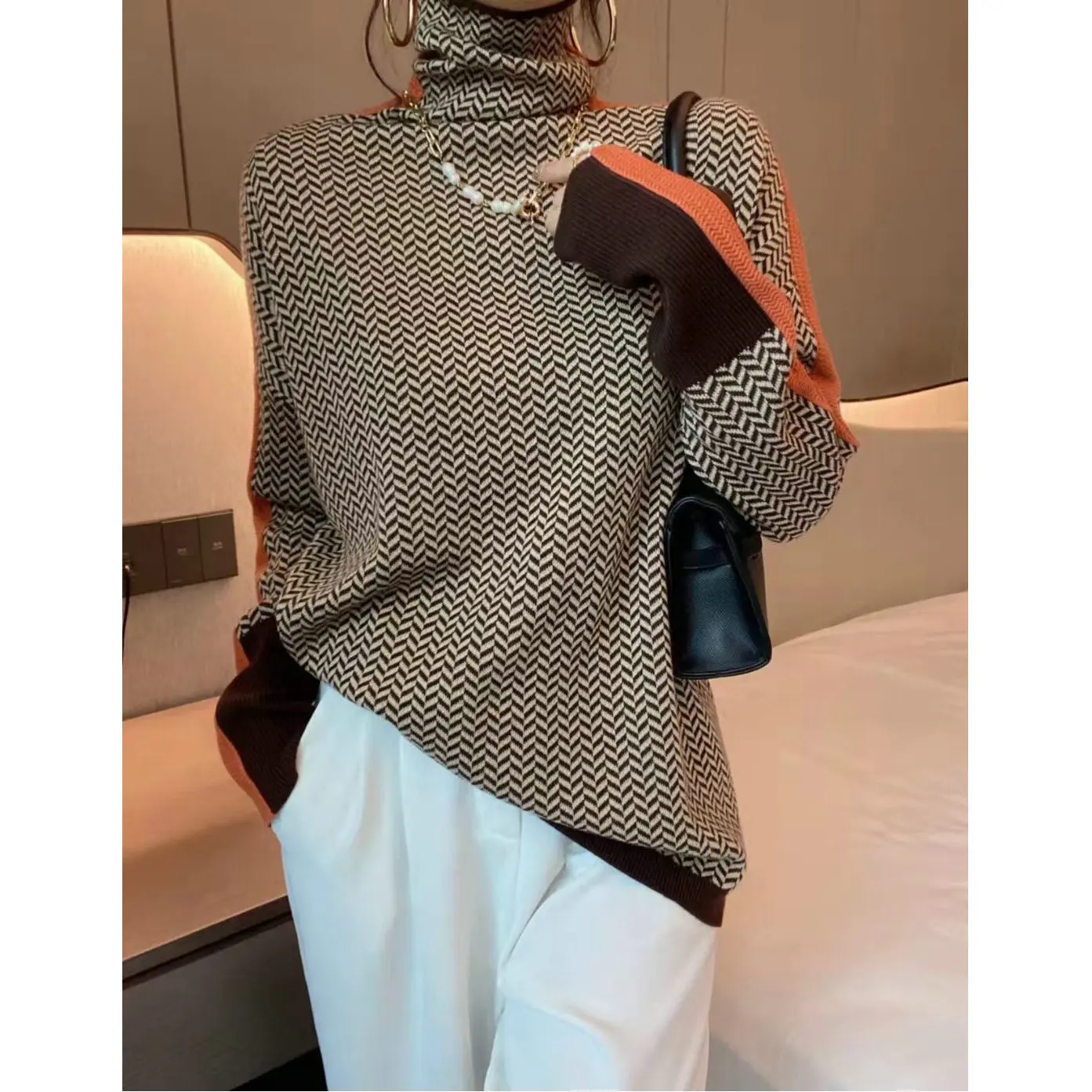
Positioning lightweight cashmere as the mid-layer in your outfit creates a perfect balance of comfort, style, and temperature regulation. This strategic placement allows the cashmere to serve as both a functional insulator and a visual focal point of your ensemble.
Color selection becomes particularly important when cashmere occupies this central position. Consider these approaches:
- Neutral cashmere mid-layers (camel, gray, ivory, navy) create versatility and timeless elegance
- Vibrant or jewel-toned pieces establish a striking focal point that outer layers can showcase
- Complementary colors that enhance both your base layer and outer layer create cohesive looks
The textural contrast between layers adds sophisticated dimension to your outfit. Lightweight cashmere’s smooth, refined appearance pairs beautifully with:
– Crisp cotton shirts underneath
– Structured wool or tweed jackets above
– Textured accessories like woven scarves or beaded jewelry
For balanced proportions, employ the “rule of three” when crafting your layered look: vary the weight, texture, and length of your three primary layers to create visual harmony. Your cashmere mid-layer often works best when it’s lighter than the outer layer but more substantial than the base layer.
Mastering effective layering techniques with cashmere as your mid-layer opens endless styling possibilities while ensuring all-day comfort. The natural temperature regulation of lightweight cashmere makes it particularly valuable in this position, as it responds to both your body heat and the external environment.
Outer Layer Strategies: What to Wear Over Your Cashmere
Selecting the right outer garments to complement your lightweight cashmere creates polished, cohesive looks while protecting these precious pieces. The key lies in choosing complementary weights, textures, and proportions that showcase your cashmere rather than overshadow it.
For structured sophistication, consider these outer layer options:
– Tailored blazers: Choose slightly relaxed fits that accommodate the cashmere without compressing it
– Lightweight wool coats: Provide warmth without overwhelming the delicate drape of cashmere
– Leather or suede jackets: Create textural contrast while offering wind protection
To prevent uncomfortable bunching when layering cashmere under structured pieces:
1. Select cashmere items with minimal bulk at the shoulders and underarms
2. Ensure sleeve lengths complement each other (shorter cashmere sleeves under longer jacket sleeves)
3. Allow approximately half an inch of cashmere to show at sleeve cuffs and necklines
Long cashmere cardigans deserve special consideration as potential outer layers themselves. These versatile pieces can function as lightweight coats in transitional weather, offering elegant drape and movement.
For less structured layering, consider:
– Oversized denim jackets: Create casual-luxe contrast with lightweight cashmere
– Utility jackets or shirt jackets: Add functional elements while protecting delicate knits
– Unstructured linen blazers: Perfect for warmer months when minimal additional warmth is needed
Remember that the weight of your outer layer should correspond to both the weight of your cashmere and the temperature. Lightweight cashmere paired with heavy outerwear creates maximum warmth, while lighter outer layers extend the wearability of your cashmere into milder seasons.
The Art of Silhouette: Balancing Proportions When Layering Cashmere
Creating visually appealing layered outfits requires thoughtful attention to proportions. The exceptional drape and relatively thin profile of lightweight cashmere make it particularly valuable for creating balanced silhouettes without unnecessary bulk.
The fundamental principle for successful layering lies in contrasting fitted and relaxed elements. When incorporating lightweight cashmere:
- Pair fitted cashmere pieces with more relaxed outer layers for elegant ease
- Balance slim-fitting cashmere sweaters with wider-leg pants or flowing skirts
- Layer more voluminous cashmere pieces over streamlined base layers
- Use long cashmere cardigans to create vertical lines that elongate the silhouette
Body type considerations play an important role in proportion management. For example:
– Petite frames benefit from monochromatic cashmere layers that create uninterrupted vertical lines
– Taller individuals can experiment with contrasting colors between layers
– Apple-shaped bodies often look best with open cardigans that create vertical visual interest
– Pear-shaped figures may prefer lightweight cashmere that skims rather than clings
To avoid the common bulky appearance that multiple layers can create:
1. Choose the thinnest possible cashmere knits for base and mid-layers
2. Ensure each layer is progressively longer than the one beneath it
3. Create clear visual breaks between layers with distinct colors or textures
4. Use strategic folding or rolling techniques to reveal glimpses of under layers
Remember that the exceptional drape of high-quality lightweight cashmere naturally creates more flattering silhouettes than stiffer, bulkier materials, giving you greater flexibility in your layering approach.
Seasonal Layering Guide: Lightweight Cashmere Throughout the Year
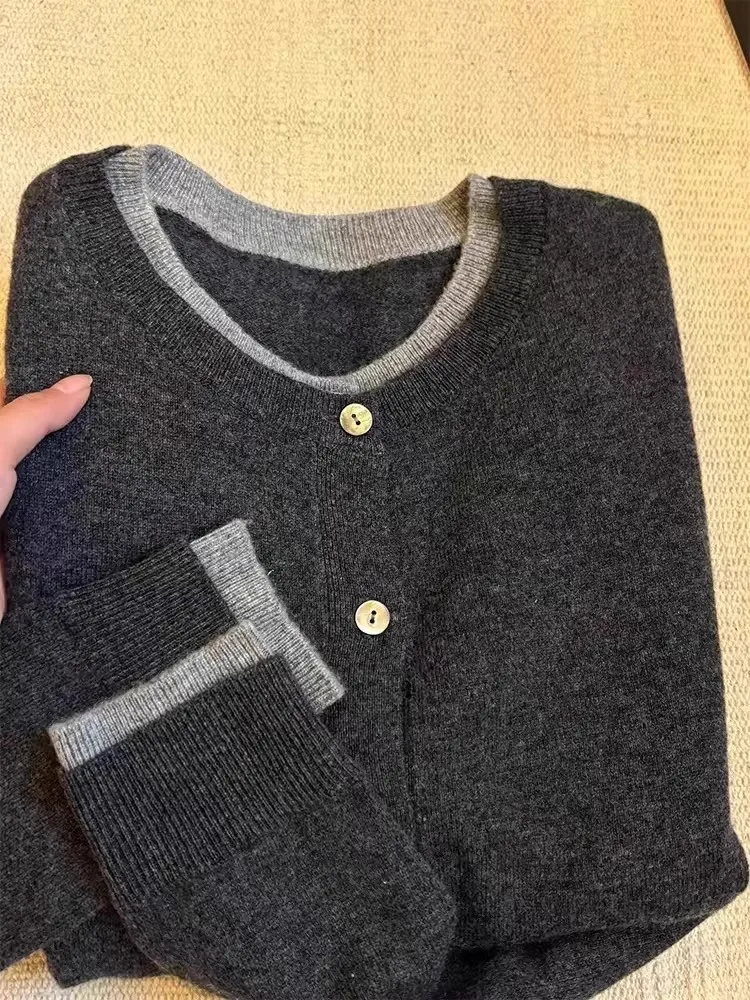
Spring Layering Strategies
Spring’s unpredictable weather makes lightweight cashmere an invaluable wardrobe ally. For these transitional months:
– Layer short-sleeve cashmere over light cotton blouses for adjustable warmth
– Pair lightweight cashmere cardigans with spring dresses for evening coverage
– Consider pastel and neutral cashmere pieces that complement spring palettes
– Implement specialized guidance for spring transitions to navigate changing temperatures
Summer Cashmere Approaches
Contrary to conventional thinking, lightweight cashmere serves valuable purposes during summer:
– Keep sleeveless or short-sleeve cashmere tops handy for overly air-conditioned environments
– Layer ultra-lightweight cashmere wraps over summer dresses for evening temperature drops
– Select breathable open-knit cashmere pieces for maximum airflow
– Choose lighter colors that reflect rather than absorb heat
Fall Layering Techniques
Fall represents peak cashmere season, offering endless layering opportunities:
– Begin incorporating lightweight cashmere cardigans over summer pieces as temperatures cool
– Layer cashmere turtlenecks under lightweight jackets and blazers
– Experiment with tonal layering using varying shades of the same color family
– Add cashmere accessories like scarves to extend the wearability of lighter outfits
Winter Warmth Strategies
During the coldest months, lightweight cashmere serves as an exceptional insulating layer:
– Use fine-gauge cashmere as a base layer under heavier winter sweaters
– Layer multiple lightweight cashmere pieces for warmth without bulk
– Keep cashmere wraps and scarves at hand for additional adjustable coverage
– Combine cashmere with other natural fibers like wool and silk for maximum insulation
This year-round approach maximizes the value and versatility of your lightweight cashmere investment, ensuring these luxurious pieces earn their place in your wardrobe across all seasons.
Occasion-Based Layering: From Office to Evening
Lightweight cashmere’s versatility extends beyond seasons to different social contexts, offering appropriate styling options for virtually any occasion. Mastering occasion-specific layering techniques ensures your cashmere investments work hardest for you.
Professional Settings
For workplace environments, lightweight cashmere creates polished, sophisticated layered looks:
– Layer fine-gauge cashmere sweaters over collared shirts for traditional office settings
– Replace standard blazers with cashmere cardigans for comfortable yet professional alternatives
– Use versatile turtlenecks as sophisticated standalone pieces or layering elements
– Select neutral tones for maximum versatility across your work wardrobe
Casual Weekends
For relaxed yet refined weekend wear:
– Pair lightweight cashmere with denim for elevated casual looks
– Layer cashmere cardigans over simple t-shirts or tanks for easy comfort
– Choose slightly looser fits for unrestricted movement without sacrificing style
– Incorporate colorful cashmere pieces that might not work in professional settings
Evening Events
Transform lightweight cashmere for evening occasions:
– Layer shimmering base layers under semi-sheer cashmere for subtle elegance
– Wrap lightweight cashmere stoles over formal attire for comfortable warmth
– Use black or jewel-toned cashmere pieces as sophisticated foundations for statement jewelry
– Select cashmere with subtle embellishments or unique details for added evening interest
Travel Ensembles
Lightweight cashmere proves invaluable for travel situations:
– Create adjustable layers to accommodate changing environments and temperatures
– Choose wrinkle-resistant cashmere pieces that maintain their appearance after long wear
– Select neutral colors that mix and match effortlessly throughout your trip
– Use cashmere wraps that double as blankets during transit
The key to occasion versatility lies in selecting adaptable lightweight cashmere pieces in timeless designs that can be dressed up or down through strategic layering and accessorizing.
Color Theory for Cashmere Layers: Creating Cohesive Combinations
Understanding color relationships transforms your layering approach from simply functional to visually striking. Lightweight cashmere, with its exceptional color absorption and subtle luster, provides the perfect medium for color experimentation.
Start by building a foundation of neutral cashmere pieces that serve as versatile building blocks:
– Soft ivory and cream tones for brightening and lightening layered looks
– Mid-tone grays and taupes that blend seamlessly with virtually any color palette
– Navy and charcoal for sophisticated depth without the starkness of black
– Camel and oatmeal shades that add warmth to any combination
Once you’ve established these basics, explore more advanced color strategies:
– Tonal layering: Combine different shades of the same color family for subtle sophistication
– Complementary colors: Pair colors opposite each other on the color wheel for vibrant contrast
– Analogous combinations: Use colors adjacent on the color wheel for harmonious blending
– Accent pops: Incorporate a single vibrant cashmere piece among neutral layers
Striped cashmere sweaters offer an excellent way to introduce pattern while maintaining color cohesion. These pieces naturally connect multiple colors in your outfit, making them valuable bridge elements in layered ensembles.
Seasonal color considerations add another dimension to your layering strategy:
– Spring and summer benefit from lighter, brighter cashmere tones
– Fall and winter welcome richer, deeper cashmere colors
– Year-round pieces in mid-tone neutrals maximize versatility
Remember that lightweight cashmere’s natural luster affects how colors appear—they often project a subtle glow that enhances your overall look, particularly in layered combinations.
The Texture Play: Pairing Lightweight Cashmere with Other Fabrics
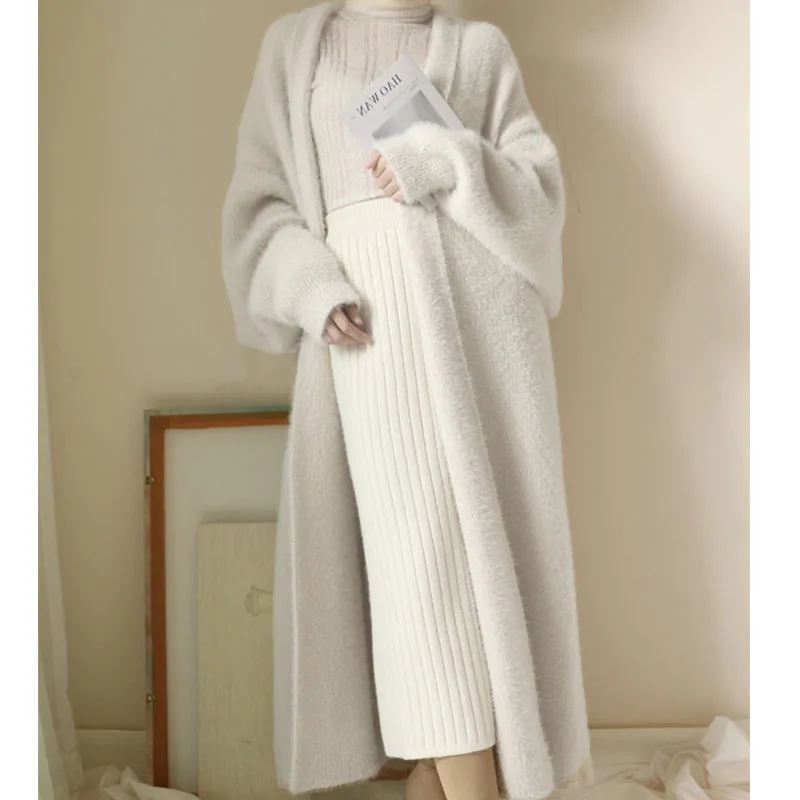
The interplay of different textures creates visual depth and tactile interest in layered outfits. Lightweight cashmere’s naturally smooth, refined texture serves as an excellent contrast or complement to various other materials.
When combining textures with lightweight cashmere, consider these effective pairings:
| Fabric | Texture Relationship | Best For | Seasonal Pairing |
|---|---|---|---|
| Silk | Complementary smoothness | Elegant, formal looks | Year-round |
| Linen | Contrasting roughness | Casual sophistication | Spring/Summer |
| Leather | Sleek structural contrast | Edge and sophistication | Fall/Winter |
| Denim | Casual textural contrast | Everyday elevated looks | Year-round |
| Wool tweeds | Rich textural complexity | Traditional layering | Fall/Winter |
| Cotton poplin | Crisp structural base | Clean professional looks | Spring/Summer |
The key to successful texture mixing lies in balancing contrast with cohesion. While textures should differ enough to create interest, they should share some common quality—weight, sheen, or drape—that unifies the overall look.
For maximum visual impact:
– Pair smooth, lightweight cashmere with more textured pieces like tweed jackets or corduroy pants
– Layer open-knit cashmere over smooth silk for subtle textural variation
– Combine different weights of cashmere for nuanced texture differences within the same material family
Avoid common texture mistakes such as:
– Competing heavy textures that create visual confusion
– Fabrics that cause friction with cashmere and may lead to pilling
– Overwhelming delicate cashmere with extremely heavy or rigid textures
Estate Cloth’s lightweight cashmere collection offers exceptional versatility for texture pairing, with pieces specifically designed to maintain their refined hand-feel even through frequent wearing and layering.
- Price range: $102.02 through $109.37 Select options This product has multiple variants. The options may be chosen on the product page
Striped Cashmere Sweaters, Women's Cashmere Pullovers
$139.68 Select options This product has multiple variants. The options may be chosen on the product pageCashmere Wool Cardigans, Women's Cashmere Cardigans
Price range: $92.23 through $92.45 Select options This product has multiple variants. The options may be chosen on the product pageCropped Cashmere Cardigans, Women's Cashmere Cardigans
$86.75 Select options This product has multiple variants. The options may be chosen on the product pageMen's Cashmere Pullovers, Short Sleeve Cashmere Sweaters
$93.56 Select options This product has multiple variants. The options may be chosen on the product pageWomen's Cashmere Cardigans, Women's Cashmere Turtlenecks
$87.89 Select options This product has multiple variants. The options may be chosen on the product page
Advanced Layering Techniques for Lightweight Cashmere
Once you’ve mastered the basics of cashmere layering, these advanced techniques will elevate your styling approach to new heights of sophistication and versatility.
Strategic Folding and Rolling
Creating visual interest through intentional manipulation:
1. The French cuff: Fold sweater sleeves back precisely to reveal contrasting shirt cuffs
2. The half-tuck: Partially tuck in the front of a lightweight cashmere sweater for casual asymmetry
3. The sleeve scrunch: Gently push up longer sleeves to create textural bunching and reveal bracelets
The “One-and-a-Half” Layer Technique
Perfect for transitional weather, this approach involves:
1. Selecting an oversized lightweight cashmere piece
2. Draping it partially off one shoulder or wearing it open
3. Creating the appearance of multiple layers with a single versatile piece
Asymmetrical Layering
Creating contemporary, dynamic looks:
1. Layer cashmere pieces of different lengths on different sides
2. Use cashmere wraps positioned asymmetrically across the body
3. Incorporate cashmere cardigans worn off one shoulder or fastened unevenly
Monochromatic Sophistication
Developing depth through subtle variation:
1. Combine different shades of the same color family
2. Layer pieces with varied textures but similar colors
3. Use accessories in the same color palette to reinforce the theme
Understanding techniques for combining cashmere with denim offers particularly valuable versatility for casual settings. This popular pairing balances luxury with approachable style, creating looks appropriate for numerous occasions.
These advanced techniques transform lightweight cashmere from simply a practical layering element into a sophisticated styling tool that expresses personal creativity while maintaining functionality.
Care and Maintenance for Layered Cashmere Pieces
Proper care ensures your lightweight cashmere maintains its exceptional quality through frequent layering. Pieces subjected to regular layering face unique maintenance challenges that require special attention.
Washing Considerations for Layered Cashmere
Lightweight cashmere used in layers requires more frequent cleaning than heavier pieces worn alone:
– Hand wash using lukewarm water and specialized cashmere shampoo
– Soak gently rather than rubbing to prevent fiber damage
– Rinse thoroughly to remove all soap residue
– Press water out between towels rather than wringing
– Dry flat on a clean towel away from direct heat or sunlight
Storage Solutions for Layering Pieces
Proper storage prevents damage between wears:
– Fold rather than hang lightweight cashmere to prevent stretching
– Use acid-free tissue between folds to prevent crease lines
– Allow 24 hours of rest between wearings when possible
– Store in breathable cotton bags rather than plastic
– Place cedar blocks nearby (not directly touching) to deter moths
Pill Prevention and Management
Frequent layering can accelerate pilling, requiring proactive management:
– Remove pills gently using a cashmere comb or battery-operated fabric shaver
– Avoid carrying rough-textured bags or wearing abrasive jewelry with cashmere
– Apply preventative cashmere spray to high-friction areas before wearing
– Consider periodic professional cleaning for heavily used pieces
Seasonal Care Transitions
When storing seasonal lightweight cashmere:
– Clean thoroughly before storage to remove invisible soils and body oils
– Repair any small holes or loose threads before they worsen
– Store in cool, dry locations away from direct sunlight
– Check periodically during off-seasons for pest issues
With proper care, high-quality lightweight cashmere improves with age, developing a softer hand while maintaining its exceptional drape and warmth—making it truly worth the investment for year-round layering.
Can Lightweight Cashmere Really Work Year-Round?
Many people associate cashmere exclusively with winter wear, but lightweight cashmere genuinely functions as a four-season fiber. Understanding the science behind this versatility helps explain why.
Lightweight cashmere’s year-round functionality stems from its unique fiber structure. The exceptionally fine fibers (under 16 microns) create millions of microscopic air pockets that provide remarkable temperature regulation properties. These air pockets trap warmth in cold conditions while allowing heat and moisture to escape in warmer environments.
The breathability factor proves particularly important for year-round wear. Unlike synthetic materials that trap heat and moisture, lightweight cashmere naturally wicks moisture away from the body and allows air circulation, preventing the clammy discomfort often associated with temperature changes.
Even in summer, lightweight cashmere serves valuable purposes:
– Protection from aggressive air conditioning in offices, restaurants, and theaters
– Evening coverage when temperatures drop after sunset
– Travel versatility when moving between different climate zones
– Base layering in extremely cold air-conditioned environments
Textile experts confirm that ultra-lightweight cashmere (12-14 microns) performs comparably to fine cotton in breathability tests while offering superior temperature regulation and significantly greater comfort against the skin.
Is Lightweight Cashmere Worth the Investment for Layering?
When considering the investment value of lightweight cashmere for layering purposes, cost-per-wear analysis reveals compelling advantages over less expensive alternatives.
High-quality lightweight cashmere offers exceptional longevity when properly maintained. While the initial purchase price may be higher than synthetic or lower-quality natural fibers, the extended lifespan—often 10+ years with proper care—significantly reduces the actual cost per wearing.
The versatility factor substantially increases value. A single lightweight cashmere piece might function as:
– A standalone garment in mild weather
– A mid-layer during transitional seasons
– A base layer in winter
– An elegant evening wrap for formal occasions
This multi-functionality across seasons and occasions dramatically improves the cost-value equation compared to single-purpose garments.
When evaluating lightweight cashmere quality for investment purposes, look for these indicators:
– Grade A cashmere with fibers under 16 microns
– Tight, even stitching with no gaps or inconsistencies
– Clear labeling indicating 2-ply or higher construction
– Established manufacturers with transparent sourcing practices
The superior comfort, temperature regulation, and aesthetic appeal of lightweight cashmere create genuine value beyond the practical considerations. The pleasure of wearing exceptionally comfortable, beautiful garments day after day represents an intangible but significant component of the investment value.

